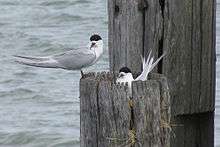White-fronted tern
| White-fronted tern | |
|---|---|
 | |
| A pair and their nest at Bayswater, Auckland City, New Zealand | |
| Scientific classification | |
| Kingdom: | Animalia |
| Phylum: | Chordata |
| Class: | Aves |
| Order: | Charadriiformes |
| Family: | Sternidae |
| Genus: | Sterna |
| Species: | S. striata |
| Binomial name | |
| Sterna striata Gmelin, 1789 | |
The white-fronted tern (Sterna striata) is the most common tern of New Zealand. It rarely swims, apart from bathing, despite having webbed feet. The species is protected.
White-fronted terns feed in large flocks by plunge diving on shoals of smelt and pilchards which have been driven to the surface by larger fish and are easily caught. Like all terns they fly with their heads and bills pointing down to see their prey.
Breeding is between October and January in large colonies on rocky cliffs and offshore islands. Originally this occurred only in New Zealand, but since 1979 they have also bred on islands in Bass Strait, north of Tasmania. Many of the birds winter in south-eastern Australia, especially juveniles.[2]
Gallery
- Adult flying at Tiritiri Matangi Island conservatory
 Adult flying past
Adult flying past Adult head markings, note the white band between the bill and the black cap
Adult head markings, note the white band between the bill and the black cap Juvenile and adult at Kapiti Coast
Juvenile and adult at Kapiti Coast Young chick
Young chick_at_Takapuna.jpg) Small flock at rest
Small flock at rest
References
- ↑ BirdLife International (2013). "Sterna striata". IUCN Red List of Threatened Species. Version 2013.2. International Union for Conservation of Nature. Retrieved 26 November 2013.
- ↑ Hutching, Gerard. "Gulls, terns and skuas – White-fronted, sooty, Antarctic and Arctic terns". Te Ara, The Encyclopedia of New Zealand. Manatū Taonga Ministry for Culture and Heritage. Retrieved 20 May 2012.
| Wikimedia Commons has media related to Sterna striata. |
| Wikispecies has information related to: Sterna striata |
This article is issued from Wikipedia - version of the 11/8/2016. The text is available under the Creative Commons Attribution/Share Alike but additional terms may apply for the media files.
